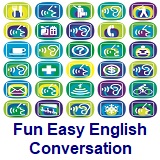|
|
| |
|
|
| |
|
|
| Fun Easy English Classroom March 27 |
|
| |
Classroom
Today
Learn about
English
indefinite pronouns |
|

Today in the Fun Easy English classroom you are going to learn about
indefinite pronouns an important part of English
grammar. |
 Hey
if you cannot understand something on this page, Hey
if you cannot understand something on this page,
then use the Fun Easy English
dictionary
(opens in a new window) |
|
|
|
 Grammar: Grammar:
Definition of an
indefinite pronoun. |
- An indefinite pronoun is a word that:
- refers to identifiable but not specific people or things
- conveys the idea of all, any, none, or some
|
- I think someone is on the roof.
- There are a few on the table.
- The following words are indefinite pronouns
- all, another, any, anyone, anything, each, everybody,
everyone, everything, few, many, nobody, none, nothing, one,
several, some, somebody, someone
|
|
 From
YOUR Teacher: From
YOUR Teacher:
These pronouns are like they sound, indefinite or not
definite. They are used to describe things which are not
specific. |
|
|
|
|
|
Additional Lessons |
 About These
Lessons About These
Lessons
The following classroom lessons are great for students
who want additional conversation, listening, and reading
practice. |
-
Conversation Lesson -
Beginner Level. Dialogs for everyday use.
Short situational dialogs for students of English as
a Foreign (EFL) or Second (ESL) Language with a
written conversation and a conversation notes
section.
|
 Conversation Lesson
4 - Informal Introductions Conversation Lesson
4 - Informal Introductions
(Beginner -
Conversation, Reading)
Dialogs for everyday use. Short situational dialogs for
students of English as a Foreign (EFL) or Second (ESL)
Language. |
Informal Introductions
Jim: Who’s the tall girl next to Barbara?
Charles: That’s Mary Anderson.
Didn’t you meet her at
Steve’s party?
Jim: No, I wasn’t at Steve’s party.
Charles: Oh! Then let me
introduce you to her now. Mary, this is my cousin Jim.
Mary: Hi, Jim. I’m glad
to meet you.
Jim: I’m glad to meet you. Can’t we sit down somewhere and talk?
Mary: Sure, let’s sit over there. |
|
Conversation Notes |
- Who’s
- The contracted form of who is. It should not be confused
with the possessive whose, which, although pronounced the same (/huwz/), has a different
meaning.
- Didn’t you meet her
- Note the use of the negative question. While generally
used to indicate the expectation of an affirmative answer, here it expresses
surprise that the answer to the question will probably—and unexpectedly—be
negative.
- Note that in this sentence, the strongest stress, and
the high point of the intonation, falls on at—although prepositions normally
receive weak stress. It is as if at, in this case, were equivalent to
present or there, as in I wasn’t present or I wasn’t there—in which the
adjective and adverb, respectively, would normally receive the strongest
sentence stress.
- Mary, this is my cousin Jim
- Notice that the introducer mentions the girl’s name
first, and introduces the young man to her (not vice versa). This is the
normal, courteous manner of introduction among speakers of American English.
- Notice the rising intonation on Mary, a name used in
direct address. See note in Dialog 3.
- Hi
- See note in Dialog 2.
- I’m glad to meet you
- Note that the second speaker says this sentence with a
different intonation than the first speaker used. The second speaker
emphasizes you. (Compare Lesson 1. How are you?) Can’t we sit down…? = Would
you like to sit down…?
- Sure
- Often used in informal conversation as a strong
affirmative response equivalent to yes, certainly, of course, etc.
|
|
Source: U.S. State Department |
|
Additional Conversation |
 Conversation Conversation
This is a collection of 36 situational conversations
which focus on spoken American English in a relatively
natural way....these
lessons are for intermediate students. |
 Conversation Conversation
This is a collection of 30 situational conversations. Each conversation is
accompanied by language notes....these
lessons are for advanced students. |
 Conversation Conversation
English conversation lessons. 52
lessons covering pronunciation, speaking,
writing, and grammar topics....these
lessons are for beginning students. |
 Conversation Conversation
English conversation lessons. 30
lessons focusing mostly on communication and
grammar topics....these
lessons are for intermediate students. |
|
|
|
|
|
|
|
 Hey Students, Hey Students,
Use this dictionary and reference to look up any words you do not
understand in Fun Easy English.
Note: search opens in a new tab. |
|
|
|
|
|
Search Fun Easy English |
|
|
|
|
|
|
|
|
|
|
|
|
|
|
|
About
Contact
Copyright
Resources
Site Map |